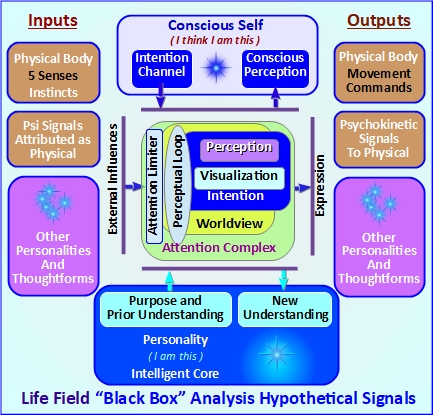Opinion 2
Abstract
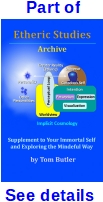 The study of metaphysics requires a cosmology based on function models that will react to known circumstances to produces expected experiences. Until I learned about Rupert Sheldrake’s Hypothesis of Formative Causation, the only approach to such a model that seemed even marginally useful was based on characteristics of the Mandelbrot Set. This essay explains how Sheldrake’s morphic fields have been adapted to satisfy the black box analysis that resulted in the Implicit Cosmology; a model that has proven very useful for studying survival-related phenomena. Additional notes about Sheldrake’s treatment by mainstream society are provided for perspective.
The study of metaphysics requires a cosmology based on function models that will react to known circumstances to produces expected experiences. Until I learned about Rupert Sheldrake’s Hypothesis of Formative Causation, the only approach to such a model that seemed even marginally useful was based on characteristics of the Mandelbrot Set. This essay explains how Sheldrake’s morphic fields have been adapted to satisfy the black box analysis that resulted in the Implicit Cosmology; a model that has proven very useful for studying survival-related phenomena. Additional notes about Sheldrake’s treatment by mainstream society are provided for perspective.
Please note that this essay was written for a website. Links are to online reference, rather than to references at the end of this document.
Inspired by an Idea
I want to tell you a little about how Rupert Sheldrake’s Hypothesis of Formative Causation helped me see that reality might be better described as fields of influence, rather than planes of existence. To do so, I first need to explain how his idea of morphic fields fits into the Implicit Cosmology.
Changing Perspective
The physical world dominates our sense of who we are. However, you are likely reading this essay because some small part of you remembers your prior existence in the greater reality; as if an ancestral memory of a lost world. My essays are me trying to pry open that vague memory of my past. It is not the study of survival I practice. It is the remembering of my actual nature.
Survival is a body-centric term that reminds us that we are physical. It is a useful term because we are all conditioned to think we are our body. If I speak of survival in the context of end-of-life, you automatically know I mean life beyond this lifetime.
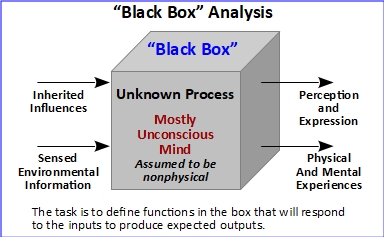 But consider how survival is from our immortal aspect; that part of us that survives. From the perspective of our actual nature, by survival, we mean that we are once again able to return our full attention to our natural environment. Why not say that, when our human dies, we return to our natural environment? Isn’t that really what happens? How do we begin thinking that way?
But consider how survival is from our immortal aspect; that part of us that survives. From the perspective of our actual nature, by survival, we mean that we are once again able to return our full attention to our natural environment. Why not say that, when our human dies, we return to our natural environment? Isn’t that really what happens? How do we begin thinking that way?
My sense is that we would be better citizens of this lifetime if we behaved as if we will eventually return to our real home. From that perspective, dying does not get us away from our actions. What we do now matters here and hereafter. Knowing we are immortal might make us more careful about how we treat our neighbor. Dying is a process some call transition.
Spiritual Anatomy
Accepting that we are an immortal personality temporarily entangled with a human in an avatar relationship implies that our actual body is not this flesh-and-bone animal we depend on to navigate the physical world. Understanding this, I have taken a lot of time trying to figure out what our real body is like; our spiritual anatomy, if you will.
Being an engineer, I am most comfortable designing models to represent what I am studying. Since we cannot dependably examine our actual nature, I use a method referred to as black box analysis. Imagine a black box which holds our spiritual body. All we know for sure is that our spiritual body is not physical and that everything we experience passes through the representative box. Our task is to figure out what must be happening in the box to produce what we experience.
Assumptions
Black box analysis is conducted to identify a specific set of functions. For instance, it is common in reverse engineering of a competitor’s device, say a radio, to figuratively put the device in the black box so that engineers can develop a competing product without knowingly violating patents.
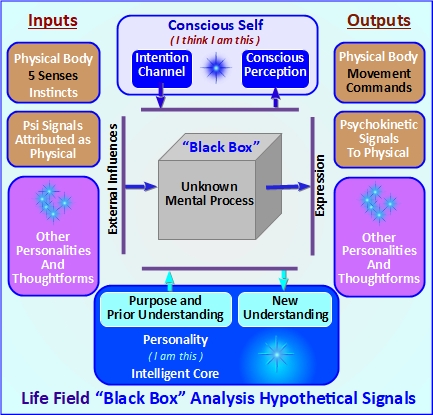
My study included consideration of:
- Commonly reported paranormal phenomena: Apparent precognition, encounters with apparitions and other haunting experiences, out of body and near-death experiences.
- Psychology: Including what I know of perception, delusion, cultural influence.
- Parapsychological: Psi functioning research such as ESP trials, remote viewing, distant healing, poltergeist phenomena, psychokinesis.
- Transcommunication: Audio and visual forms of ITC, mental and physical mediumship, precipitation, apports, hauntings.
As you can see in the Life Field Black Box” Analysis Hypothetical Signals Diagram above, I have made the following assumptions:
- Psi: All of the inputs and outputs to the black box are psi signals. (See the Perception essay)
- Preprocessing of awareness: Information is first processed in mostly unconscious mind before being presented to Conscious Self. (See the How We Think essay)
- Meaning of sensed information is assigned according to habit: From the perspective of our mostly unconscious mind, psi signals from the etheric and those from the physical are the same. The difference is how mind has been conditioned to assign meaning. (See the Conditional Free Will essay)
- Mind-brain duality: The brain acts as transmitter-receiver to convert physical senses to psi signals and psi signals to operating commands for the body. (See the Trans-Survival Hypothesis essay)
- Core Intelligence, memory-perception and Conscious Self act as independent parts of a whole: We are a life field composed of Conscious Self as the experiencer, mostly unconscious mind as judge and record keeper and a core intelligence which is the source of our purpose and receiver of understanding. (See the Prime Imperative essay)
- Interaction with environment moderated by worldview: Mostly unconscious mind is the source of expression and perception for our life field. (See the Perception essay)
- Conscious Self directs with intention: Perception and expression are based on habit informed by prior experience, instincts and acquired understanding. (See the On Being Psychic Essay)
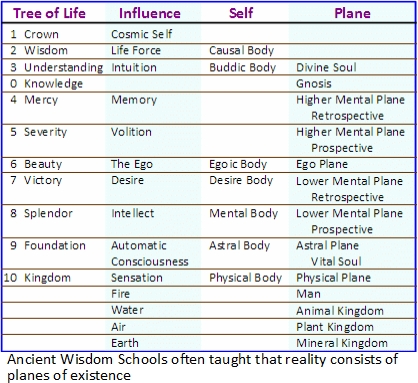
Point of View
People need not be engaged in conversation to make a cooperative community work. A two-way exchange of ideas is ideal but having members of the community who are willing to express well-considered ideas to the public is also important. The trick to make this work is to have an idea, think it out so as to understand the implications and consequences and then express that understanding in an understandable form that is readily accessible to others. It is from such a well-considered idea posed by Rupert Sheldrake that I found reason to change the fundamental model I use in my study of metaphysics.
My first effort to formalize my metaphysical point of view was based on the popular wisdom of the time. With a few notable exceptions, nearly all of the commonly cited models looked like a layer cake with the physical near the bottom and the most spiritually mature planes of existence at the top. The one shown here is typical. The diagram was originally used in the Handbook of Metaphysics, my first effort to define a cosmology.
There are a few contemporary contenders. The models based on the multiverse concept are very popular, but they seem to have nothing to do with who we are, our experiences and our immortality. In the same sense, quantum theories also seem to be little more than brain teaser distractions. Resist chasing down those rabbit holes when you are trying to find a useful way to think of your spiritual nature.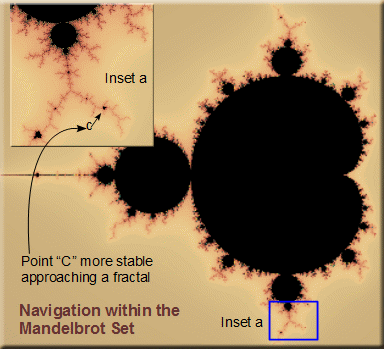
I have always been fascinated with the Mandelbrot Set. In that, a point-by-point plot of a simple formula involving real and imaginary numbers: Z n+1 = Zn2 + C, where Z0 = C produces an infinitely complex imaginary space. As shown in the inset of the Mandelbrot Set plot, the Apple Man fractal can be found an infinite number of times as one telescopes into the region between -2 and 1 on the Real Number Plane (horizontal) and -1 and 1 on the Imaginary Number Plane. (vertical).
The value of the Mandelbrot Set is that it is an example of how simple organizing principles might produce very complex structures that are related by the principle and initial assumption. The plot is much like a hierarchy of nested fields as proposed by Sheldrake.
That appeals to my sense that God is order. The Mandelbrot Set is an exercise in math, but it involves principles of Chaos Theory (chaotic space) and fractals. Relating it to the black box analysis exercise, reality can be considered a thought exercise, the foundation of which is intended order imposed on a chaotic environment by the expression of intention. That is the Creative Process: Changes in reality are expressed via personality’s attention on an imagined outcome with the intention to make it so.
Morphic Fields
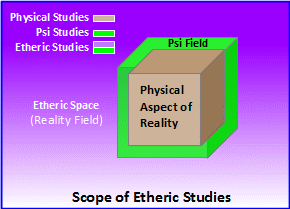 The paranormalist community has needed a workable survival hypothesis. My approach to develop one was to use the If This, then What kind of analysis. That is, given a reported apparently paranormal experience is actual, then what might have caused it and how.
The paranormalist community has needed a workable survival hypothesis. My approach to develop one was to use the If This, then What kind of analysis. That is, given a reported apparently paranormal experience is actual, then what might have caused it and how.
As an engineer, I needed to find a rational mechanism by which reality as we know it might be formed. Not in the sense of a creation theory, but in the sense of how our conscious self relates to our physical body and how all of that relates to the rest of reality. The study of that brought me to thoughtforms; more generally, etheric fields.
In Etheric Studies, conceptually, a field represents a set of elements with common characteristics which are bound together by a common influence. From the Etheric Fields Essay, you can see that I characterized etheric fields as:
- Nonlocal: Ubiquitous or everywhere at once. It may be correct to say that everywhere is here. This is a physical space perspective. In the etheric, movement is accomplished by changing one’s mind. See Nonlocal in the Transcommunication
- Homogenous: No apparent direction or intensity of propagation. Terms like wave and frequency have no meaning when discussing etheric fields. The physical concept of direction might be thought of in etheric terms as the influence of attention on visualized outcome. (See the On Being Psychic Essay)
- Confined by Perceptual Agreement: Movement in etheric space is directed by intention but limited by the ability to visualize the intended outcome. This, in turn, is limited by perception which is moderated by the person’s worldview.
A consequence of Perceptual Agreement is that, for etheric fields and especially life fields which intend the characteristics of individual fields, movement in the etheric is by changing perception. As such an etheric equivalent of physical propagation is the process of changing perception.
- Influenced by intentionality: Etheric fields are responsive to intention for the manifestation of intended order.
- A precursor to objective reality: Physical energy and matter are seen as a result of the influence of intention on an etheric field. That is, physical energy and matter are expressions of life fields.
This is a good place to remind you that it is unlikely you will ever see the models I work with in an academic treatise on the nature of reality. I am a metaphysician’s equivalent of a shade tree mechanic. My claim of credibility is that none of the formal philosophers I have considered have had access to the kind of research and evidence we have today. The Implicit Cosmology is the first model I have found that helps me extrapolate further understanding. This is my story and I am sticking with it … for now. It is for you to test your teacher.
Morphogenesis
The process of an organism’s cell dividing into a particular kind of cell (skin, bone, blood) is known as morphogenesis. The mechanism controlling morphogenesis remains unclear despite the many theories designed to explain the process. Biology is not my field. This is not about biology. It is about the fact that biologist Rupert Sheldrake’s proposal that a nonphysical memory field controls the process helps solve the black box puzzle. He refers to the field as a morphic field (morphogenetic field).
Sheldrake provides a good overview of his theory in Morphic Resonance and Morphic Fields – an Introduction. In it, he summarizes:
Morphic Fields: A Summary
- They are self-organizing wholes.
- They have both a spatial and a temporal aspect, and organize spatial-temporal patterns of vibratory or rhythmic activity.
- They attract the systems under their influence towards characteristic forms and patterns of activity, whose coming-into-being they organize and whose integrity they maintain. The ends or goals towards which morphic fields attract the systems under their influence are called attractors. The pathways by which systems usually reach these attractors are called chreodes.
- They interrelate and co-ordinate the morphic units or holons that lie within them, which in turn are wholes organized by morphic fields. Morphic fields contain other morphic fields within them in a nested hierarchy or holarchy.
- They are structures of probability, and their organizing activity is probabilistic.
- They contain a built-in memory given by self-resonance with a morphic unit’s own past and by morphic resonance with all previous similar systems. This memory is cumulative. The more often particular patterns of activity are repeated, the more habitual they tend to become.
I will paraphrase using terms from the Implicit Cosmology
Morphic Fields (paraphrasing Sheldrake)
- They are self-organizing wholes as bound by Organizing Principles, especially the Principle of Perceptual Agreement.
- They are not bound by space or time. Put another way, they are unique to and support specific species as the population evolves over time and anywhere in the world.
- Sheldrake explains that morphic fields control morphogenesis via a process he describes as morphic resonance guided by nature’s habit. That is, organisms form in the same way they have always been formed. They do so by what I refer to as the expression of intended order expressed by the species’ collective morphogenic mind. This appears to be essentially the same process involved in the etheric-to-physical formation of transform ITC phenomena.
- Morphic fields are hierarchical in a similar way as fractals. Looking back at the Mandelbrot Set, above, they are specific to a part of the organism while being a part of the whole organism. Sheldrake refers to the nested morphic field controlling individual cells or group of cells as holons. Each holon represents a local attractor for the part of the organism under its influence.
Think of a holon as a discrete “mind” controlling a local collective of entities (skin cells for instance) but which is also part of the collective of holons composing the top fractal of what I refer to as the morphogenetic mind for that species. The nested hierarchy architecture appears to be a fundamental characteristic of reality.
- Nature’s habit does not mean every change in behavior of the organism is included in the memory. It means that successful changes that further the survival of the organism are more likely to be included. It appears Worldview in the Attention Complex discussed below is modified in much the same way. The current state of Worldview and Nature’s Habit has considerable momentum. Sheldrake has referred to this point in terms of Nature’s Habit being evolved in small increments by the influence of successful, creative solutions to environmental challenges.
Worldview
In trying to develop a sensible model for survival based on what we are learning from transcommunication, I struggled to account for the different ways people experience these phenomena. For instance, two people recording under the same conditions typically collect messages of different tone. That tone tends to agree with the way the individual views the world so that a level-headed person tends to collect useful information while a fearful person more often collects scary messages.
The Hypothesis of Formative Causation was the first model I have encountered that fit with my growing sense that fractals and fields are an effective way to model reality.
I described worldview as an Organizing Principle for the Implicit Cosmology:
Worldview Organizing Principle: a learned response moderated by understanding, and further explained that, as one of the functional areas of the life field, Worldview appears as a thoughtform containing the memory, knowledge and point of view of the personality. It is much like a database. When a person is born, the worldview database is essentially empty, but it has a front-end algorithm which represents Personality’s maturity as its degree of progression and an inclination toward experiences that offer the opportunity for specific areas of understanding.
The worldview database is populated by culture, family, media, religion and schools as biased by the front-end algorithm. It is the worldview that acts as a filter to determine how the person reacts to situations–prejudices, beliefs, acceptance or rejection of information. Worldview follows a person through transition and influences postmortem experiences.
Worldview resists change, but evolution of worldview occurs in small increments with ambiguous outcomes of the Perceptual Loop. Creative solutions to environmental challenges, if they do not represent radical changes, are expected to evolve worldview.
Compare worldview with Sheldrake’s Nature’s habit. Concepts I have adopted from the Hypothesis of Formative Causation include:
- All organisms are organized according to a database field containing information which represents their intended form.
This has become the foundation argument for the life field concept. I argue in the Implicit Cosmology that reality consists of a nested hierarchy of life fields and their expressions.
- This formative field is an etheric field, rather than a physical field.
To have the present everywhere aspect and to exist beyond the lifetime of instances of the organism it supports, it is necessary that formative fields are in the etheric. Conversely, if the field is in the etheric and the organism is in the physical, there must be an etheric-to-physical interface. We think this interface may be similar to the transform effect we see in EVP in which it appears a small psi signal is amplified by mixing it with a larger, chaotic signal; possibly via stochastic amplification.
- Formative fields are typically arranged in a nested hierarchy with a top organism and a many-to-one regions of subfields.
This nested hierarchy model is applied in the Implicit Cosmology as the relationship between Source and aspects of Source, and as life field and their expressions.
- Formative fields resist change but may evolve according to a set of rules that allows for incremental changes.
This is the foundation argument for the Mindful Way. Mainstream research is increasingly showing that information we receive from the environment is first processed in our mostly unconscious mind. We only become aware of the results of that processing.
Black Box Solution
After compiling everything I know about paranormal phenomena, the human experience and survival, the set of functions that seem to satisfy the requirements posed by known and hypothesized inputs and outputs are represented by the diagram below.
Avatar: There may or may not be a physical body. A physical body must be part of the model if the conscious self is in a physical lifetime as two merged life field sharing Worldview and probably sharing Conscious Self. The body may or may not be human.
Personality: The attractor element of a life field. It is the part of us that issues purpose and collects understanding. The influence is itself, a creative process: attention (Attention Complex) on an imagined outcome (Purpose) to produce an intended order (Understanding).
Conscious Self: As the experiencer, Conscious Self is the part of a life field that provides the perspective from which Personality experience reality. Conscious Self is like a traveling video camera. As you read this, it is your conscious self that is aware of your experience. That experience is moderated by Worldview in the mostly unconscious Attention Complex so that your thoughts about this writing, for instance, and your perception of its meaning are based on a combination of what is written and how you are able to visualize it based on past experience. (See the Perceptual Agreement essay)
Attention Complex: Mind is a part of the life field that is organized by Personality’s decision to pay attention to reality and intention of Conscious Self to interact. It is the seat of our sentience while Personality is the seat of our purpose and ultimate collector of understanding.
Attention Limiter: As will be explained in the upcoming First Sight essay, a psi signal expressed by the avatar, another personality or an event is presented to the Perceptual Loop to be compared to what is in Worldview. The perceptual Loop is predisposed to look for some signals and ignore others.
Perceptual Loop: This is a process that will be better explained in the upcoming First Sight essay. Environmental information is visualized (characterized in some way, probably as a gestalt thoughtform) and compared with Worldview. This may be a rapid, iterative process as the first visualization is modified according to what is found in Worldview and re-visualized, possibly many times, to find the best fit. At the end of the process, the information is either rejected and not consciously experienced or it is experienced in a form that agrees with worldview. A maybe outcome is possible, in which case, the information is experienced in a modified form and also causes a modest change in worldview.
A more liberal maybe decision enables the development of greater lucidity. It is made more liberal by practicing suspended judgment.
It is interesting to wonder how the Perceptual Loop knows to stop trying to match the visualized version of a signal with the content of Worldview. The calculation for a point in a Mandelbrot Set plot has two tests for completion. One is if the designated number of tries have been made. The other is if the result is moving toward infinity or toward a stable number. It may be that the Perceptual Loop is wired to test if the result is becoming more in agreement with Worldview or less. There is evidently a tolerance in the calculation that is related to how open the person is to new ideas. That would be a test for ambiguity that decides the maybe outcome … an outcome that is beneficial for increasing lucidity.
Perception: For perception, the Perceptual Loop is a process that compares sensed psi signals from an entangled body (if present) or other life fields. Conscious Self’s perception of reality is represented by the Worldview functional area as it is processed in the Attention Complex.
If this is true, we can only become conscious of what we can visualize.
Expression: For expression, the Perceptual Loop compares intention to express (speak, move, consider, visualize) from Conscious Self with the content of Worldview. What is expressed (to other life fields, to the body as a thought) is what is intended and what best fits that intention in Worldview.
If this is true, we can only express what we can visualize.
Worldview: Worldview is basically a database holding prior understanding, instincts of the avatar and spiritual instincts, purpose, memory and Conscious Self’s sense of reality. By itself, it is just a database, but that database represents the limits and conditions by which the life field is able to interact with reality.
Intention: The Intention field represents the generator of the actual expression (outward) and perception (inward) signal. If engaged, an expression (speak, move, consider, visualize) signal is sent into the environment and to Conscious Self. The Intention Field supports the mechanism by which the Perceptual Loop is able to test possible expression or perception with Worldview.
Conscious Self does not generate the words or thoughts it expresses. It intends to react, and the Attention Complex compares the circumstance with memory held in Worldview and produces the words to the body or the psi signal to the environment. It is a fine point to note that expression must send a perceptual signal to enable Conscious Self so that it can be aware of what it is expressing.
Visualization: The Perceptual Loop depends on the ability to formulate a sense of what has been received or what is to be expressed. Thus, the Visualization functional area is part of the Perceptual Loop and the mechanism by which an expression is composed.
Perception Output: The Perception functional area produces an output that is presented to Conscious Self’s as an awareness. The output is also expressed into the environment, possibly to be acknowledged by another personality. The signal might be to the avatar, if present, as a movement command.
Note that the only influence Conscious Self has on the Attention Complex is intention. That is why the Mindful Way is designed around the conscious decision to habitually intend to gain understanding from experiences. Also, note that the Attention Complex is situated between Conscious Self and Core Intelligence. The ability of Conscious Self to sense its core personality (lucidity) is a function of how well Worldview agrees with the actual nature of reality.
This is also true of information from other personalities, with or without an avatar. You discarnate loved one may express to you the need to look after a friend, but that suggestion must pass through your Attention Complex. If you do not believe the loved one still exists, the suggestion will likely be ignored. If you think only demons communicate, the suggestion might be modified via the Perceptual Loop based on your Worldview into a scary thought. It is by increasing your openness to external contact, and intention to sense the information as it is expressed, that you gain clear perception of the other side.
Note that the entire Attention Complex is in the etheric as a hierarchical set of fields. The combination of Personality (Core Intelligence and purpose), Attention Complex (mind) and Conscious Self functional areas represent a life field. I have concluded that all living organisms have the same functional areas but express them to more or less a degree depending on their situation and purpose. Thus, a life field is a fractal.
Rupert Sheldrake
And so, I have explained the importance of Rupert Sheldrake’s Hypothesis of Formative Causation to the model I have developed for the Implicit Cosmology. This is obviously not a biography of the man, but I do want to tell you a little about what he has endured to publicly present the hypothesis and other paranormal-related ideas.
It is generally understood that a Ph.D. risks his or her science career by becoming associated with anything paranormal. Perhaps that is why so many of our parapsychologists are retired academics and no longer need to worry about their professional standing. Sheldrake is a poster boy victim of this sort of prejudice.
Evolution
Of course, the dominant theory for how organisms have developed is Charles Darwin’s 1859 Theory of Evolution. In that, organisms naturally mutate in small increments and the mutations that support continuation of the species is passed on to offspring and those that do not are lost.
Jean-Baptiste Lamarck proposed the Theory of Inheritance of Acquired Characteristics in 1802. He proposed that organisms acquired skills during life that might be pass on to offspring. The theory was not well received because there was no obvious way for such traits to be passed through the fertilized egg.
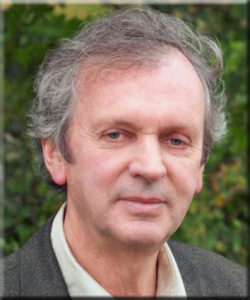
Sheldrake’s Hypothesis of Formative Causation requires the presence of a nonphysical field he refers to as a morphic field. This field must be capable of retaining information about a physical organism, applying that information in the development of each instance of the organism and accepting changes to the memory reflecting adaptation of instance of the organism to environmental influences. His theory also requires a mechanism by which the subtle fields are able to have a two-way interaction with the physical organisms they support.
While people continue to argue about evolution from a strictly mainstream, physical world point of view, parapsychologists have been developing a viable theory which supports a mechanism by which acquired traits might be propagated. It is known today that there is a nonphysical field permeating physical space that has two characteristics important to Sheldrake’s theory. The Psi Field, as it is known, has no apparent distance, so that everywhere appears to be here. The second is that the field retains information which is everywhere available.
A deep discussion of Sheldrake’s theory is beyond the scope of this essay. You might consider looking at such articles as Acquired Traits Can Be Inherited via Small RNAs.
The idea of a Psi Field is considered pseudoscience by mainstream academia. This is probably because those who would judge the validity of Sheldrake’s theory, based on their learned understanding of evolution, do not accept the existence of the Psi Field. That is because the Psi Field theory is also deemed pseudoscience. Thus blinded, Sheldrake’s peers have given him harsh criticism. That, in turn, has been a green light for the science apologist of the world to attack Sheldrake with even more harsh criticism.
If you are serious about understanding things paranormal, it is important that you understand the relationship between those who claim to be scientists studying these phenomena and those of us who are practitioners, advocates and experiencers.
Consider these sources for background about how Sheldrake has been attacked:
Craig Weiler’s Weiler Psi blog – The Big TED Controversy of 2013, Part 1 and The Big TED Controversy of 2013, Part 2.
The short version is that Sheldrake was invited to speak at a TEDx (Technology, Entertainment, Design – Ideas worth sharing) event. There was an outcry from conservative mainstream TED supporters when the video of Sheldrake’s talk was posted. They were reportedly insulted by talk of alternative theories of science.
There was substantial debate on the TED discussion board and the video was eventually reposted, albeit on a backwater page of the TED website. The fact remains that some of the dominant people in TED were determined to censor Sheldrake’s work.
Wikipedia biography of a living person: Rupert Sheldrake
Should you have any doubt as to who was trying to do the censoring, the skeptic editors in Wikepedia simultaneously began attacking the Wikipedia biography of a living person: Rupert Sheldrake. You can follow the discussion amongst the editors on the Talk Page. To hide the edit war, the skeptic editors installed a bot to frequently archive the Talk Page. I recommend you search the yellow box on the right for “Butler.” Archive 15 is a good example.
I was banned from editing the Sheldrake page March 2014 because I was violating the Wikipedia:Requests for arbitration/Pseudoscience#Final decision. In that, you can see that the skeptic editors have managed to have an official position for Wikipedia on what is pseudoscience. Having established that Sheldrake is a pseudoscientist, any support of him is seen as a violation of the Pseudoscience Arbitration. See the Wikipedia: Requests for arbitration/Pseudoscience article for access information.
PSI Wars: TED, Wikipedia and the Battle for the Internet Kindle Edition
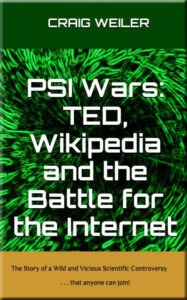 Craig Weiler, writer of the Weiler-Psi blog, was involved in the Ted-Sheldrake controversy from the beginning. He has written an excellent account of the whole event in the very readable PSI Wars: TED, Wikipedia and the Battle for the Internet. I recommend that you consider reading it as a case study in skeptic censorship of frontier ideas. From Amazon:
Craig Weiler, writer of the Weiler-Psi blog, was involved in the Ted-Sheldrake controversy from the beginning. He has written an excellent account of the whole event in the very readable PSI Wars: TED, Wikipedia and the Battle for the Internet. I recommend that you consider reading it as a case study in skeptic censorship of frontier ideas. From Amazon:
In journalistic fashion, Craig Weiler relates what began as a seemingly harmless attempt to make sure that TED talk videos maintained a high standard and how this exploded into a wild scientific controversy. When the nonprofit company took down one of their YouTube videos by scientist Rupert Sheldrake, who had given a speech on the philosophy of science, they ignited a fierce discussion that eventually grew to include hundreds of people spanning the globe. For a while, ordinary folks, distinguished scientists, Internet trolls and even a Nobel Prize winning physicist all got together to hash out the greatest scientific controversy . . . ever.
Perspective
There are two points to be taken from this essay. First, I credit Rupert Sheldrake for turning my thoughts toward fields as the solution to the black box exercise.
Second, good ideas seldom become popular wisdom without a good publicist or informed champion. From my perspective as a person seeking to understand our spiritual nature, Sheldrake’s struggle to convince the scientific community to take his theories seriously makes him a perfect example of why we need a cooperative community.
The TED people are mainstream. Clearly, to them, ideas worth sharing are only those that confirm their worldview. I spent a lot of time trying to talk the controlling skeptic editors in Wikipedia to write balanced paranormalist articles. They are mainstream people who are very protective of their conservative worldview. As such, it was no surprise to see them attack the Sheldrake article with so much determination to discredit his ideas.
I am banned for life from editing the Sheldrake article. The main reason that was possible is that so few of our people have been willing to cooperate with others to explain these concepts in a rational manner. Of course, I tried to recruit help editing in Wikipedia. One paranormalist explained to me that, after seeing the abuse I have received in Wikipedia, he would not risk becoming an editor.
You may think that all is well in paranormal land. In fact, we are rapidly sliding into irrelevance, and are, each day, moving further from understanding our actual nature.
Words to think about as you enjoy your freedom to study things paranormal:
No man is an island, entire of itself; every man is a piece of the continent, a part of the main. If a clod be washed away by the sea, Europe is the less, as well as if a promontory were, as well as if a manor of thy friend’s or of thine own were: any man’s death diminishes me, because I am involved in mankind, and therefore never send to know for whom the bells tolls; it tolls for thee. John Donne: Poems “For whom the bell tolls”
![]()

